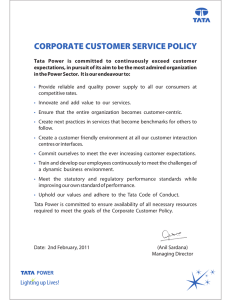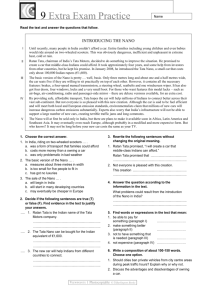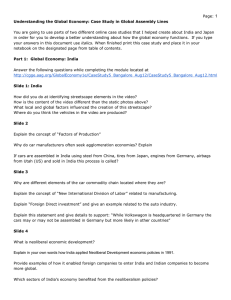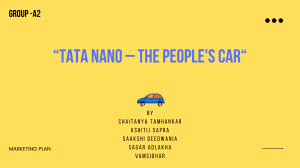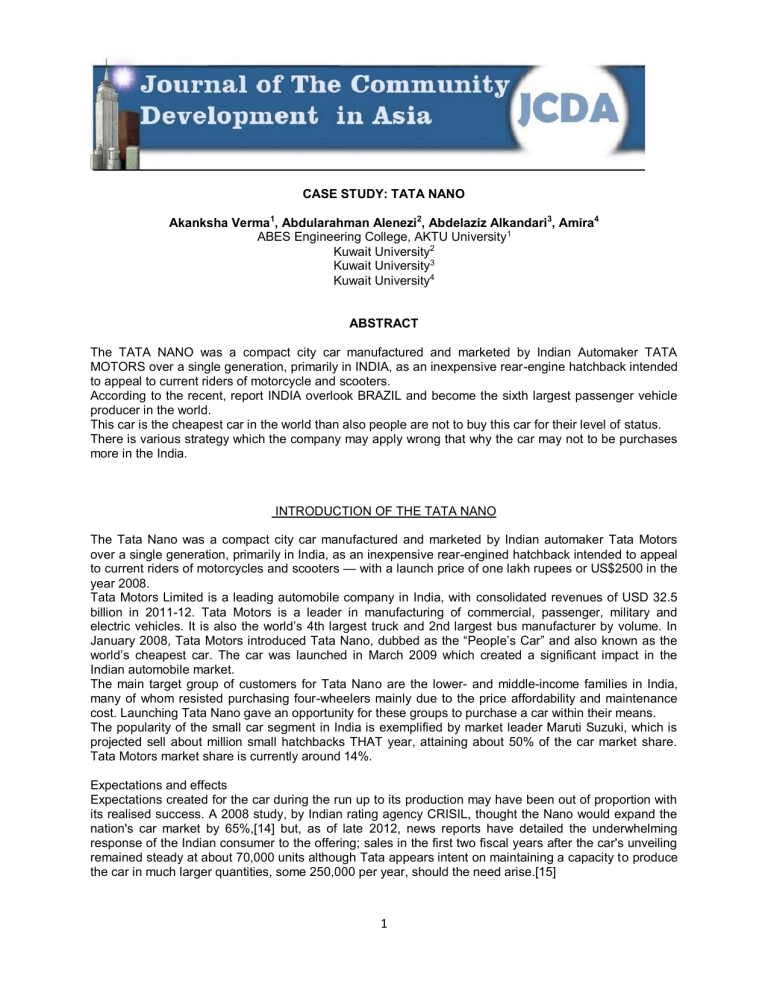
CASE STUDY: TATA NANO Akanksha Verma1, Abdularahman Alenezi2, Abdelaziz Alkandari3, Amira4 ABES Engineering College, AKTU University1 Kuwait University2 Kuwait University3 Kuwait University4 ABSTRACT The TATA NANO was a compact city car manufactured and marketed by Indian Automaker TATA MOTORS over a single generation, primarily in INDIA, as an inexpensive rear-engine hatchback intended to appeal to current riders of motorcycle and scooters. According to the recent, report INDIA overlook BRAZIL and become the sixth largest passenger vehicle producer in the world. This car is the cheapest car in the world than also people are not to buy this car for their level of status. There is various strategy which the company may apply wrong that why the car may not to be purchases more in the India. INTRODUCTION OF THE TATA NANO The Tata Nano was a compact city car manufactured and marketed by Indian automaker Tata Motors over a single generation, primarily in India, as an inexpensive rear-engined hatchback intended to appeal to current riders of motorcycles and scooters — with a launch price of one lakh rupees or US$2500 in the year 2008. Tata Motors Limited is a leading automobile company in India, with consolidated revenues of USD 32.5 billion in 2011-12. Tata Motors is a leader in manufacturing of commercial, passenger, military and electric vehicles. It is also the world’s 4th largest truck and 2nd largest bus manufacturer by volume. In January 2008, Tata Motors introduced Tata Nano, dubbed as the “People’s Car” and also known as the world’s cheapest car. The car was launched in March 2009 which created a significant impact in the Indian automobile market. The main target group of customers for Tata Nano are the lower- and middle-income families in India, many of whom resisted purchasing four-wheelers mainly due to the price affordability and maintenance cost. Launching Tata Nano gave an opportunity for these groups to purchase a car within their means. The popularity of the small car segment in India is exemplified by market leader Maruti Suzuki, which is projected sell about million small hatchbacks THAT year, attaining about 50% of the car market share. Tata Motors market share is currently around 14%. Expectations and effects Expectations created for the car during the run up to its production may have been out of proportion with its realised success. A 2008 study, by Indian rating agency CRISIL, thought the Nano would expand the nation's car market by 65%,[14] but, as of late 2012, news reports have detailed the underwhelming response of the Indian consumer to the offering; sales in the first two fiscal years after the car's unveiling remained steady at about 70,000 units although Tata appears intent on maintaining a capacity to produce the car in much larger quantities, some 250,000 per year, should the need arise.[15] 1 Issues faced by tata nano 1.Poor positioning -The main issue thats why tata nano fails, was its poor positioning. they were not able to make better positioning in customers mind. They advertised that tata nano is a very affordable car by all even by the lower middle-class people, but in india people buys the car for their prestigious to show their prestige in the society. and no one wants to show that they have buy a lower middle-class car .so this was the main problem that they face, that was poor positioning. 2.Bleak Future Tata nano company written off some costs associated with the Nano, did not comment on the car's future. That future looks bleak though. Tata Motors has said investments in the Nano factory could be used for making other products and that the company would focus on "growing and attractive segments of the passenger vehicle market". 3. Safety problems of carbecause of low price of car the company was not able to give a strong security backup .so this car was lack of safety , the car was strong enough in comparison of others .so this is also an issue that they face because they launched the car at very low price and in that price they couldn't offer the strong security backup . 4.looks factorthe tata nano car was very small in size and didn't look like the luxury cars and in that price, they also couldn't offer the model like other luxury models of car .so this was also the reason that were facing that was its very normal and non- stylish looks. 5. Increasing competitionAfter launching a lakhtakiya car at very low prices, other company’s falls for competition with their lowprice strategy so other company starts doing competition and tata company faced that. Tata Motors Limited is a leading automobile company in India, with consolidated revenues of USD 32.5 billion in 2011-12. Tata Motors is a leader in manufacturing of commercial, passenger, military and electric vehicles. It is also the world’s 4th largest truck and 2nd largest bus manufacturer by volume. In January 2008, Tata Motors introduced Tata Nano, dubbed as the “People’s Car” and also known as the world’s cheapest car. The car was launched in March 2009 which created a significant impact in the Indian automobile market. The main target group of customers for Tata Nano are the lower- and middle-income families in India, many of whom resisted purchasing four-wheelers mainly due to the price affordability and maintenance cost. Launching Tata Nano gave an opportunity for these groups to purchase a car within their means. Solutions of the issues 2 1.There are lots of talks about Tata Nano nowadays. Millions of people are waiting for the launch of Tata Nano. With sufficient features this car provides basic features like 4 seats and good mileage. The Tata Nano is 3.1m long, 1.5m wide and 1.6m high vehicle which makes it one of the shortest cars in India. The Tata Nano is not only famous in India but the whole world is looking forward to Tata Nano. I am driving a Maruti 800 and some other small cars of Maruti since last six years. To be honest i can’t afford a car costlier than Maruti 800. So i would like to have a car which has cost that fits in my pocket and which has sufficient features, good mileage, low price and nothing else. And Tata Nano has exactly what i want in a car, low price, good mileage. It has an engine of 623cc which is probably the least powerful engine in India but what performance this car will deliver will be interesting to see. 2.THE WASHER PUMPER F THE TATA NANO MAY HAVE TO CHANGE SUCH THAT IT IS EASY FORM THE PEOPLE TO WASH THE CAR AND IT IS ALSO A VERY BIG PROBLEM WHICH IS TO BE SOLVE. 3.The looks of the nano car was also the reason of its failure so i think that they also should change the models of the car. to look like a luxurious car. Company background Tata Motors Limited is a leading automobile company in India, with consolidated revenues of USD 32.5 billion in 2011-12. Tata Motors is a leader in manufacturing of commercial, passenger, military and electric vehicles. It is also the world’s 4th largest truck and 2nd largest bus manufacturer by volume. In January 2008, Tata Motors introduced Tata Nano, dubbed as the “People’s Car” and also known as the world’s cheapest car. The car was launched in March 2009 which created a significant impact in the Indian automobile market. The main target group of customers for Tata Nano are the lower- and middle-income families in India, many of whom resisted purchasing four-wheelers mainly due to the price affordability and maintenance cost. Launching Tata Nano gave an opportunity for these groups to purchase a car within their means Recommendations Tata nano car is a product .my ideas regarding to this car failure that there are various factors that should be improved by the tata nano. 1)Better positioning in customer’s mind: The company was not able to make the better positioning in consumer’s mind. They advertised that it is the cheapest car in India. but most of the peoples buy car for their status symbol.and the compay advertised that it is the “latakia” and cheapest car for those who are not able to buy expensive and luxurious car. this was the main reason of the failure of the tata nano because they did not make it the status symbol. And no one wants to show that he is not capable to purchase an expensive or luxurious car. 2) Target Market: Promotion Stratagy TATA Nano should be marketed as niche segment product rather than everyone’s product. Age wise market segmentation will be from the age 18 to 30 year and above 55 years. More than 65% population is under the age of 35 years so there is significant market available in 18 to 30 years segment. Potential buyers will be rich kids who will be turning 18 and will be getting car as their birthday gift, single men and women earning good salary and living alone in cities. DINK (Double Income No Kids) families who will not be planning for kids for another 3 to 5 years. These demographics are steadily increasing; they are in need of a car which addresses their priorities like 3 mileage, performance, safety, easy parking and easy maneuverability. Nano can be ideal for them. Identifying this niche and promoting Nano for this market segment can revitalize the dying demand. Shed the tag of cheapest car & promote it as small car with no compromise 3) Add Luxury – (Change Price preposition) One thing that TATA got totally wrong is Indian mindset regarding low cost model, For Majority Indians, car is not a necessity or about convenience, for them it is a luxury and a sense of pride is attached to it. When Nano was marketed as cheapest car with minimalist approach whole fun and excitement of buying a first car got killed. People don’t really feel proud about showing off Nano, which is a big factor behind purchasing a car. A movie like Do Duni Char has rightly reflected the sentiments of middle-class family purchasing their first car. Rather than selling it at dirt cheap rate sell it at a higher price with lot of cool and safety features. High end model of Nano can be sold at around 3.5 lacs this will improve profit margin for TATA and for the dealers as well. 4) Make it Powerful and Safest Small Car – (Change in Product) Let me be very clear if TATA really want Nano to be successful it has to be reengineered, with current engine no amount of marketing or promotion is going to help Nano. Rather than making it poor people’s first car, make it at rich people’s first car. First thing that requires a change is an engine, rather than having 750 cc engine, equip Nano with powerful high cc engine probably Vista’s engine can be used here that will save lot of cost also. Second Make it two-seater car remaining space should be used for safety features and for boot space. This will also increase lot of boot space. So even if it is a small car it will have very powerful engine, international level of safety standards and unmatched boot space, thus three primary concern of consumer is being taken care of. These changes can be game changer because there are e no such cars available in the market. In a true sense it can be small car with no compromise 5) It’s Urban car – (Place) Sometimes product success has lot to do with its scarcity. Unavailability of a particular product creates cult status as everybody wants to have it but very few will get it. TATA should to focus on urban area only. Even the demographic segmentation suggests that target group is more urban i.e. Top 50 cities, roughly around 150 million people it is more than Germany and UK put together. Promoting Nano in few cities will significantly reduce the cost of marketing as well. Apart from this TATA can think of promoting Nano in tourist spot like Goa, Dehradun, Shimla etc TATA Nano can be used there for rentals it will be the one of the unique ways to promote it. As these are the couples most probably both earning and will soon be buying a car, they may not have thought about buying Nano until they will be experiencing it. Once they will experience it, feature rich Nano will be attractive buy for them. CONCLUSION The failure of Tata Nano present with a great lesson for all the marketers the car was positioned as a symbol of social liberty and equality. It was positioned as dream car of common man of India. It was targeting the laymen who want to have a car and it got successful to some extent but only till a functional level. The Nano made sense in terms of a social mission, on a purely functional level. Good quality engineering focused on the task of making something reliable and safe as cheap as possible. Sell it to people with not much money. But it has been criticized all around as the one to the greatest positioning blunder as even the most cost-effective producers do not label their products as cheap. Here the cheap has a great social connotation and the social tag because nobody aspires to buy the cheapest thing on the market, and driving around in a car is as big a statement as you get to make. Human psychology is that the motivation behind buying isn't to have a car, or a shampoo, or whatever the product is. If a 4 product is positioned as poor ‘s product then poor people will definitely avoid it because they don ‘t wants to be viewed as poor yet. The marketer just needs to place their product right in the minds of customer and the brands like Armani, Raymond ‘s, Toyota and even other brands of Tata are examples of that. So, positioning remains the main mantra behind the success of any product REFERENCES http://www.huffingtonpost.in/dhritiman-hazarika/a-game-plan-for-tata-nano-against-the-renault-kwid/. http://www.autofocusasia.com/management/tata-nano [Accessed 20 Nov. 2016]. 5
